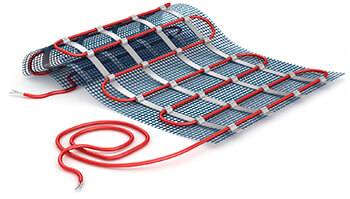Radiant Floor Heating and Cooling
No More Cold Feet
 Radiant floor heating is ductless, noise resistant, and distributes heat evenly through every room.
Radiant floor heating is ductless, noise resistant, and distributes heat evenly through every room.
Heating your home with a forced-air furnace isn’t your only option when you have concrete floors. You can save energy and create a healthier, more comfortable living environment by having the floor itself distribute the heat from the ground up by a radiant in-floor heating system.
How It Works
The most popular and most cost efficient radiant heating systems use water. Water-filled tubes are heated by an energy source such as a standard gas/oil-fired boiler, or water heater. The science behind radiant floor heating is quite simple: Tubes that circulate hot water are installed in the concrete slab when it’s poured, turning the thermal mass of the concrete into an inconspicuous radiator of warm, even heat. It is even possible to regulate the temperature from room to room by using zoning valves or pumps inside the tubes.
Benefits of Hydronic Radiant Floor Heating and Cooling
- Among the many benefits, radiant floor heating is a ductless system, meaning:
- No noisy blowing of air
- No dust or circulated allergens through air vents
- No energy loss due to duct leaks
- No necessary cleaning maintenance like air ducts
- Floor heating requires less energy to maintain the level of heat comfort in your home
Other Considerations
While all heating systems have their drawbacks, radiant floor heating is no exception. When researching possible heating solutions, think of some of these considerations:
- Depending on the floor material in your home, some insulating materials (e.g.: thick carpet or area rugs) decreases the response time of your system. Constant heat may also dry or crack wooden floors if not properly treated for this heating application.
- Larger rooms have greater thermal mass, which means it may take considerably more time to heat or cool the floors. This makes it more difficult to program timed temperature changes.
